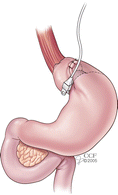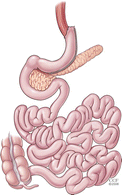Surgery
Roux-en-Y gastric bypass (RYGB)
Laparoscopic adjustable gastric band (LAGB)
Laparoscopic sleeve gastrectomy (LSG)
Description
Involves making a small pouch of the stomach, just below the esophagus, that empties into a loop of jejunum. Surgery can be performed both open and laparoscopically
A device is placed around the uppermost portion of the stomach and can be adjusted to allow tailoring of the stoma outlet
The stomach is reduced in size by removal of a large portion of the stomach following the major curvature of the stomach
Images



% Excess weight loss [7]a
1 year
63.31 %
34.26 %
51.49 %
5 years
64.92 %
57.23 %
–
Preoperative Evaluation
The purpose of the preoperative evaluation for bariatric surgery is to assess the risk of complications, to identify and optimize medical conditions that increase a patient’s risk, and to confirm that the patient meets the recommended criteria for bariatric surgery [12].
A validated 90-day mortality risk assessment tool for patients undergoing bariatric surgery is shown in Table 38.2 [13], but the data remains mixed [14]. A risk scoring system for serious complications is also available [15].
Class based on OS-MRS (points)
Mortality (90-day) (%)
A (0–1)
0.2
B (2–3)
1.2
C (4–5)
2.4
Cardiac risk assessment and optimization is similar in obese patient as other patients undergoing noncardiac surgery (see Chap. 6), but can be challenging due to limitations of the cardiac evaluation and cardiac testing due to weight limits of myocardial perfusion scans and cardiac catheterization tables, technical limitations of echocardiogram, and poor functional capacity for exercise stress testing. A cardiologist should be consulted if there are questions in regard to appropriate noninvasive testing.
Obesity-related comorbidities that influence preoperative cardiac assessment and management of obese patients include coronary artery disease (CAD), congestive heart failure (CHF), DM, chronic renal insufficiency, cerebrovascular disease, hypertension, and poor exercise capacity [16].
Pulmonary risk assessment prior to bariatric surgery is important. Obese patients have increased demand for ventilation, increased work of breathing, respiratory muscle inefficiency, and decreased lung volumes. These conditions are made worse when the patient is supine, under anesthesia, and with insufflation during laparoscopy.
Pulmonary conditions associated with obesity to explore in the preoperative period include OSA and OHS (see Chap. 29), pulmonary hypertension (see Chap. 30), cor pulmonale, and history of venous thromboembolic disease (see Chap. 31).
Any testing by the preoperative medical consultant should be determined by the history and physical exam (e.g., consideration of echocardiogram in the setting of CHF, pulmonary hypertension, or poor exercise capacity suspected to be due to a cardiopulmonary cause).
Bariatric surgeons often have their own protocols for preoperative testing. Depending on which type of bariatric surgery is planned, the preoperative evaluation may include ultrasound of the gallbladder, endoscopy, upper GI series, fasting blood work (CBC, CMP, lipid panel, HbA1c, TSH, vitamin D 25-OH, vitamin B12, iron studies, ferritin), ECG, CXR, PFTs (ABG, full spirometry, and lung volumes), or sleep study [12].
Medications should be reviewed carefully in the preoperative setting to anticipate any necessary changes or possible complications following surgery. For those patients who are taking numerous medications, controlled or extended-release medications, or medications with narrow therapeutic indices, an evaluation by a pharmacist with experience in bariatric surgery patients should be considered.
A dietician should meet with the patient to optimize the patient’s nutrition prior to surgery and to prepare them for post-bariatric surgery diet. Many patients are placed on a very-low-calorie diet (1,000 cal per day for approximately 3 weeks) before surgery to significantly reduce liver volume and improve operative exposure of the stomach.
Another important component to the preoperative evaluation is a psychosocial evaluation for substance abuse, psychiatric disease, or social circumstances that may hinder the patient’s ability to make the necessary long-term lifestyle changes.
Perioperative Management
Nutrition
Proper hydration and adequate nutrition are particularly important following bariatric surgery.
Postoperative bariatric diets vary according to institution but most follow a similar progression. Patients are usually able to start a clear liquid diet within the first 24 h after surgery and advance to a full liquid or soft and pureed diet prior to discharge under the direction of an experienced dietician.
Patients should be reminded to eat more slowly and to eat more frequent but smaller meals, to stop eating when they are full, and to separate food from fluids by at least 30 min.
The dietary changes following bariatric surgery are typically better tolerated for patients undergoing LAGB as opposed to RYGB or LSG since the band is not tightened when it is placed initially.
Bariatric patients are at risk for nutrient deficiencies. Following RYGB and LSG, patients are started on a multivitamin with minerals and iron per day, calcium 1,200–1,500 mg per day (calcium citrate is preferred as it does not require an acid environment for absorption), and vitamin D3 (cholecalciferol) 800–1,200 IU per day. Patients may require vitamin B12 supplementation following surgery.
Stay updated, free articles. Join our Telegram channel

Full access? Get Clinical Tree


